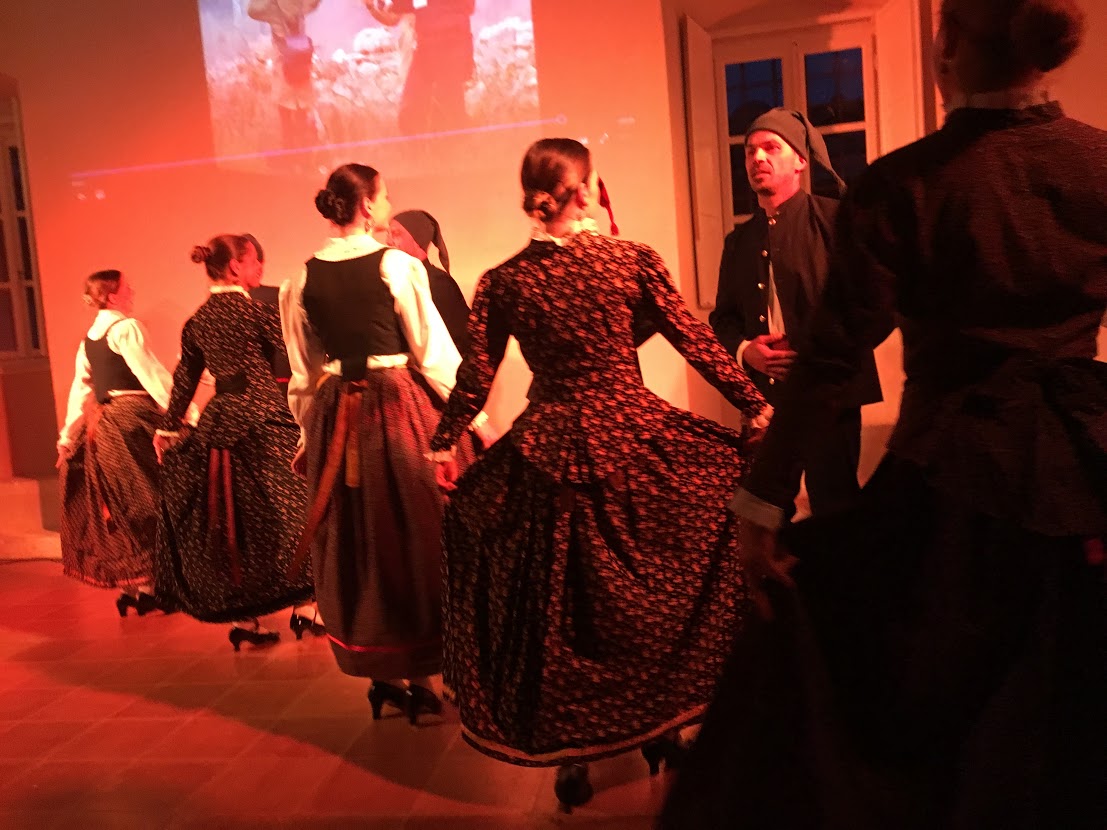May 6, 2019 – An Erasmus project exploring the UNESCO heritage of four destinations in Croatia, Cyprus, Italy and Spain is proving an excellent education about the considerable UNESCO heritage of Hvar.
One of the many attractions that the island of Hvar possesses is its considerable UNESCO heritage. So much so, in fact, that it has more UNESCO heritage than any other island in the world. I used to think that the number of UNESCO heritages was 5, but I learned it was actually 6 in a recent interview with Hvar Tourist Board director, Petar Razovic, I learned that the number is actually six.
The six are: UNESCO World Heritage Site, the Stari Grad Plain. Intangible UNESCO heritage: the Za Krizen procession, agave lace from the Benedictine Nuns, Mediterranean Diet, klapa singing, and the one I had always omitted, the art of dry stone walling.

I had been intending to write an article about all six, but it seems I was beaten to it. Over the weekend, a teacher from Hvar’s elementary school contacted me to tell me out a great Erasmus project called UNESCO passport. Hvar’s elementary school explains it like this:
The “UNESCO Passport“ is a project in which we are going to explore our cultural heritage which is under UNESCO’s protection on our island. We believe that heritage shapes our identity and our everyday life so we think that it is important to include it in our educational process. Our partners in this project are schools from Italy, Spain and Cyprus. There will be four teachers and students’ visits during the two years of the project. The first visit will be held in Hvar during April 2019. The following visit is expected to be held in Italy in 2019. The short-term visits in Spain and Cyprus will be held in the year 2020. Each visit will last between 3 and 5 days.
It seems that the April visit to Hvar was a great success. Once again, I hand the words over to the school and its trip report:

The arrival of our project partners from Italy, Spain and Cyprus in Hvar (9th April)
Our partners came to the town of Hvar by the catamarans during the afternoon on 9th April. At 7.30 pm there was a small opening ceremony to welcome our guests in the Arsenal Gallery.
The local male klapa “Galešnik“ and the local folklore group “Šaltin“ performed at this welcoming ceremony. Mrs Nada Jeličić, the headmistress of Hvar Elementary School welcomed the guests and then Helga Buratović (the coordinator of the project) said a few words about the aims and main activities of this wonderful Erasmus+ project.

After that, our students briefly introduced themselves in front of the audience. At the end of the ceremony, our eighth-grade student Tina Radaić sang the song “Hallelujah“. Our students then went to their homes and our project team went to dinner together with the visiting teachers.
Day 1 of the mobility in Hvar (10th April)
Due to the rainy weather, we started our activities in the Elementary School of Hvar.
At the very beginning, our school female klapa (led by their mentor Miranda Krivić – the music teacher) performed the song “Diridonda“. Following that, our guests showed us the power-point presentations about their towns and schools.

After a short coffee break, there was a lace-making workshop (a kind of string art) whose result was some interesting works of art. The activities continued after lunch.
First, our visitors went on a guided tour of the Hvar town centre. Their guide was Zrinka Zokić, one of our teachers but also a renowned tourist guide. Among other landmarks, they visited the Benedictine monastery and saw the famous Hvar agave lace.

After that, we all again met at school where our Hvar students held their Prezi presentations showing our UNESCO protected tangible and intangible heritage. At the end of these presentations, there was a quiz to see how much our partners remembered.
The winners of the quiz were Cypriot students who showed amazing concentration and knowledge. During the short break, our visitors tried vanilla ice-cream with olive oil having orange flavour (the product of Radojković oil mill) and our Dalmatian dessert “rožata“.
At the end of the day, our IT teacher Niko Karković prepared an online evaluation in our IT classroom. Later, all the students went to a pizzeria together, and the teachers went to a local “konoba“ (Luviji) for the wine tasting event.
They were accompanied by our project team members Ela Matković, Natalija Šćepanović and Helga Buratović.

Day 2 of the mobility in Hvar (11th April)
The second day was full of activities. We started the day with workshops.
The first one was held by our biology teacher Ružica Ćurin who taught the students about different herbs that can be used for various medicinal and cosmetic purposes.

The students took part in a quiz trying to guess the species of plant by its smell. They were excellent at this task since they were really interested in her lecture.
After that, our English teacher Magda Tamim organised the workshop of decorating traditional cakes called “paprenjaci“. She also explained to them how to make these cakes. The final products were lovely.
After a short break, we all met at the hotel “Riva“ which kindly “loaned“ us its kitchen where the local chef Mr Pero Hure cooked a tasty “gregada“ for us. He explained how to prepare it and then we all tasted it.

After lunch, we went to a nearby island Palmižana where our visitors tried to catch fish themselves. The best fisherman was Karlo Domančić who managed to catch fish.
During the hours spent on Palmižana, the rainy weather was kind to so we even had some sunny hours during this afternoon. When we came back to Hvar we took part in another workshop trying to make creams from beeswax, olive oil, lavender and immortelle.
Following that, we went to our school where our IT teacher Niko Karković taught us how to use Canva, a digital tool used for graphic design. Our students have started to create our digital Mediterranean diet cookery book using this tool.

The book will be one of the final products of our project. Finally, although we were all tired, the Cypriot student Petr gave us a fantastic presentation about their Lefkara lace (also protected by UNESCO). He really deserved the big applause and our respect.
Day 3 of the mobility in Hvar (12th April)
We started the activities by going to the Hvar’s fortress where the visitors could enjoy the beautiful view of the town and the sea. We found out important information about the history of this significant cultural landmark and then we went to Velo Grablje by bus.
In Velo Grablje, a nearby village, we were welcomed by Mr Ivica Tomičić who sang and played the accordion for us. He told us the story about the beginnings of this village and about the life of the village in the past.

It is the story about growing vines and lavender, but also about building the amazing drywalls that surround this village. The art of building drywalls was added to UNESCO’s list of intangible heritage in November 2018. Mr Ivica kindly shared small lavender gifts to our guests.
In the end, one of our students Roko and Mr Ivica performed a small part from a play “Ribanje i ribarsko prigovaranje“ written by the Renaissance poet Petar Hektorović.
We continued our way to Stari Grad where we were welcomed by Mr Vinko Tarbušković (the professor of history) who showed us the most important locations and ruins of the Stari Grad’s Plain.
He told us about the beginnings of Stari Grad (ancient Pharos) and about the history of this plain and its Greek division.
After lunch, we visited Tvrdalj (home of the poet Petar Hektorović). The students of Elementary School Petar Hektorović in Stari Grad gave us another performance of “Ribanje“.
Our students (members of the photography group led by Miss Katija Barbić, the TE teacher) shared small notebooks with photos of famous Tvrdalj inscriptions to the visiting students and their task was to find these inscriptions and take photos of them by themselves.
The teachers had a working coffee break where they brought some important conclusions for the continuation of the project.
At five o’clock we went to Vrbanj, one of the villages that take part in the Procession Following the Cross. We took part in the local procession and later the local singers gave us the performance of The Lamentation of Christ, which is an important part of the UNESCO protected procession Following the Cross.

The local priest and the local people prepared pancakes and refreshments for our visitors. We are very grateful to all of them.
At 7 pm we came back to Hvar and our school. We prepared a small farewell party in one of the classrooms.
The students evaluated the daily activities and then Helga Buratović summarised what the students learned during the few days of the stay in Hvar and gave a short farewell speech for our visitors.
We also shared the mobility attendance certificates and some small farewell presents which were partly prepared by our school cooperative “Faria“, led by Marjana Tudor (geography teacher) and Ivančica Katušić-Domančić (Art teacher).
The feeling that we all shared, in the end, was really worth all the effort. Some of the visiting students expressed their gratitude for getting the chance to take part in this Erasmus+ project. And we really became aware of the immense benefits that students gain from these school exchange projects.
To learn more about the island of Hvar, check out the Total Croatia Hvar in a Page guide.









